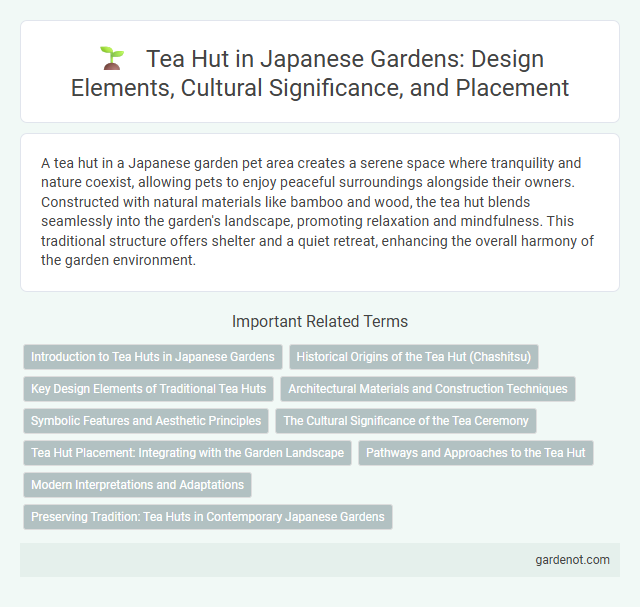A tea hut in a Japanese garden pet area creates a serene space where tranquility and nature coexist, allowing pets to enjoy peaceful surroundings alongside their owners. Constructed with natural materials like bamboo and wood, the tea hut blends seamlessly into the garden's landscape, promoting relaxation and mindfulness. This traditional structure offers shelter and a quiet retreat, enhancing the overall harmony of the garden environment.
Introduction to Tea Huts in Japanese Gardens
Tea huts in Japanese gardens embody traditional architecture designed for the Japanese tea ceremony, creating a serene space for meditation and social gatherings. These simple structures, often constructed from natural materials like bamboo and wood, harmonize with the surrounding landscape to promote tranquility and mindfulness. Emphasizing wabi-sabi aesthetics, tea huts reflect the beauty of imperfection and the deep cultural heritage of chanoyu, or the way of tea.
Historical Origins of the Tea Hut (Chashitsu)
The tea hut, or chashitsu, originated in 16th-century Japan during the Muromachi period, closely linked to the tea master Sen no Rikyu, who emphasized simplicity and wabi-sabi aesthetics. Traditionally constructed with natural materials such as bamboo, wood, and tatami mats, the chashitsu serves as a dedicated space for the Japanese tea ceremony (chanoyu). Its design reflects Zen Buddhist principles, fostering a serene environment for meditation, ritual, and appreciation of tea.
Key Design Elements of Traditional Tea Huts
Traditional tea huts in Japanese gardens incorporate minimalist design with natural materials such as bamboo, wood, and thatched roofing to emphasize harmony with the surrounding environment. Key elements include small, low entrances called nijiriguchi, encouraging humility and mindfulness, while tatami-matted interiors create intimate spaces for tea ceremonies. Sliding shoji screens and subdued lighting enhance the serene atmosphere, reflecting principles of wabi-sabi and Zen Buddhism.
Architectural Materials and Construction Techniques
Traditional Japanese tea huts, or chashitsu, utilize natural materials such as bamboo, cedar, and tatami mats to create an authentic and serene atmosphere. Construction techniques emphasize simplicity and harmony with nature, using hand-crafted wooden joinery and clay walls that enhance insulation and aesthetics. Roofs are often thatched or tiled, reflecting regional styles and sustainable building practices intrinsic to Japanese garden architecture.
Symbolic Features and Aesthetic Principles
The tea hut, or chashitsu, embodies Wabi-Sabi principles, emphasizing simplicity, natural textures, and an imperfect beauty that fosters tranquility. Its symbolic features include minimalistic architecture designed to harmonize with the surrounding landscape, promoting mindfulness during the tea ceremony. The aesthetic principles highlight asymmetry, subdued colors, and the use of organic materials such as bamboo and wood to create an intimate, serene atmosphere.
The Cultural Significance of the Tea Ceremony
The tea hut, or chashitsu, serves as a sacred space where the Japanese tea ceremony, known as chanoyu, is performed, embodying principles of harmony, respect, purity, and tranquility. This ritual, rooted in Zen Buddhism, fosters mindfulness and appreciation of simplicity, reflecting Japanese aesthetics and philosophy. The tea hut's design emphasizes natural materials and minimalism, enhancing the ceremonial experience and cultural reverence for nature and tradition.
Tea Hut Placement: Integrating with the Garden Landscape
Tea huts in Japanese gardens are strategically placed to harmonize with the natural surroundings, often nestled near water features or shaded by trees to enhance tranquility. Their positioning encourages contemplative moments, offering views of carefully arranged plants and stone pathways that reflect seasonal changes. This integration not only supports the traditional tea ceremony but also strengthens the connection between architecture and the garden's aesthetic rhythm.
Pathways and Approaches to the Tea Hut
Pathways and approaches to the Japanese garden tea hut are meticulously designed to enhance tranquility and mindfulness. Stone or gravel paths often meander through mossy grounds and carefully placed stepping stones, guiding visitors with intentional pauses that promote contemplation. These approaches typically incorporate subtle elevation changes and natural elements such as bamboo fences and lanterns to create a harmonious transition between the garden and the tea hut, embodying wabi-sabi aesthetics.
Modern Interpretations and Adaptations
Modern interpretations of Japanese tea huts blend traditional architectural elements with contemporary materials like glass and steel to create minimalist, light-filled spaces for tea ceremonies. These adaptations emphasize seamless integration with surrounding gardens while incorporating sustainable design principles, enhancing the contemplative experience. Innovative layouts often merge indoor and outdoor environments, preserving cultural symbolism while meeting modern lifestyle needs.
Preserving Tradition: Tea Huts in Contemporary Japanese Gardens
Tea huts in contemporary Japanese gardens serve as vital spaces preserving the centuries-old tradition of tea ceremonies, embodying the essence of wabi-sabi aesthetics and Zen principles. These structures often feature natural materials like bamboo and wood, harmonizing with the garden's tranquility while facilitating mindful tea preparation and appreciation. By maintaining these tea huts, modern gardens uphold cultural heritage and provide immersive experiences that connect visitors to Japan's historical tea culture.
Tea hut Infographic

 gardenot.com
gardenot.com